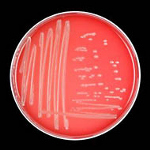You are here:
Escherichia coli

Escherichia coli are a naturally occurring germ (commensal) in the intestine of birds and warm-blooded mammals. It is likewise an integral part of the intestinal flora of humans. Certain strains of Escherichia coli can cause serious diseases in animals and humans.
Clinical picture and sources of infection
The significance of Escherichia coli as a cause for infections in humans has already been known since the 1920s. E. coli play an important role as a frequent cause of bacterial urinary tract infections. Furthermore, they are feared as a cause of blood poisoning and hospital infections. The germs are, therefore, also referred to as extra-intestinal pathogenic E. coli (ExPEC), ie as pathogens which can cause diseases outside the intestine.
Since the 1940s E. coli has, however, also become increasingly known as a cause of diseases affecting the gastrointestinal tract of humans. These pathogens are also referred to as enteropathogenic E. coli (EPEC), ie pathogens affecting the gastrointestinal tract. EPEC infections were the largest cause of gastrointestinal infections (gastroenteritis) in babies and infants in industrial states for two decades after the end of World War II. Improved hospital hygiene and better living conditions contributed towards a decline of EPEC infections in industrial states; in developing countries they still play an important role as pathogens.
Other E. coli affecting the intestine such as enteroinvasive E. coli (EIEC) and enterotoxic E. coli.(ETEC), have a particularly high significance in countries of warmer climatic zones with poor hygiene standards whereas enteroaggregative E. coli (EAGEC) are also relevant as a diarrhoea cause in industrial states.
E. coli strains STEC and EHEC as causes for bloody diarrhoeas and the haemolytic-uraemic syndrome
Some variants of E. coli were described for the first time as zoonosis pathogens in 1982 after the Vero (VT) or Shiga toxins (Stx) had been identified which can deploy a considerable organ damaging effect. These E. coli VTEC/STEC cause serious diarrhoea in humans. Some of their representatives, which are also referred to as enterohaemorrhagic E. coli (EHEC), are known as causes for bloody diarrhoea (haemorrhagic colitis) and kidney failure (haemolytic uraemic syndrome, HUS).
The E. coli strains STEC and EHEC occur naturally in the intestine of ruminants such as cattle, sheep and goats. Animals excreting STEC/EHEC germs do not show any symptoms of the disease. The bacteria get into the environment through faeces.
In the field of food products in particular animal foods such as meat and milk products are at risk as far as STEC/EHEC germ contamination is concerned. The direct transmission from animals to humans and from humans to humans plays an important role at the propagation of STEC/EHEC infections.
Opinion
(12)Other documents
(1)| Date | Title | Size |
|---|---|---|
|
03.09.2012 Minutes of an expert discussion held at the BfR
|
Hygiene in sprout production |
50.0 KB
|
